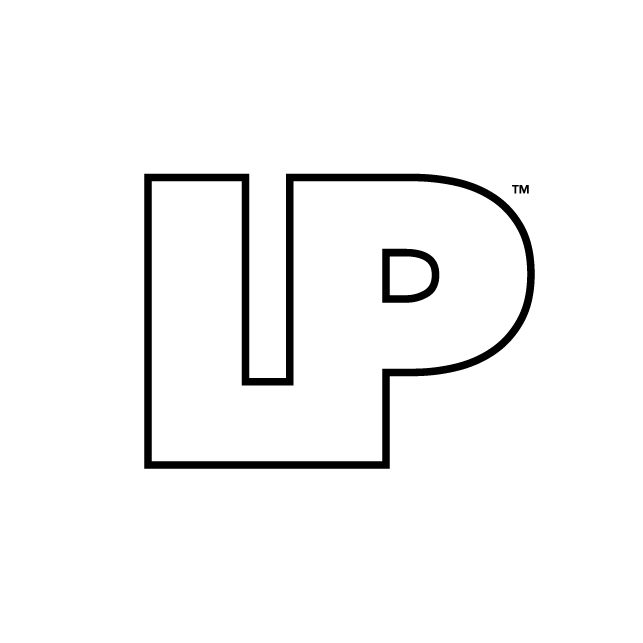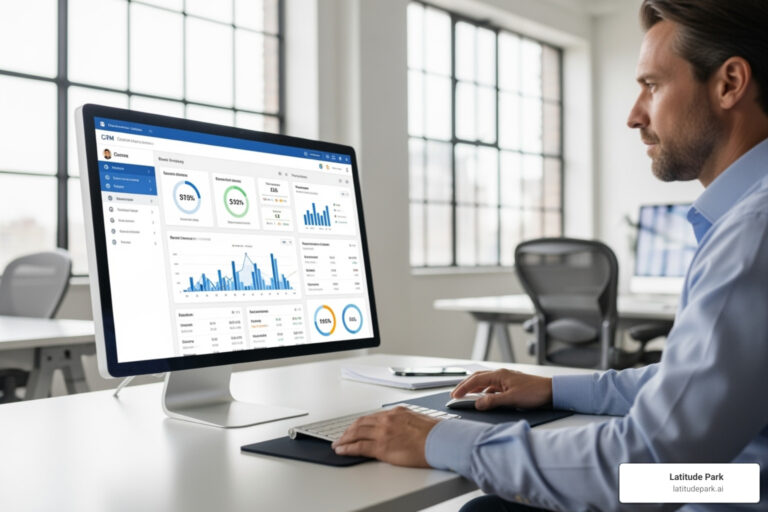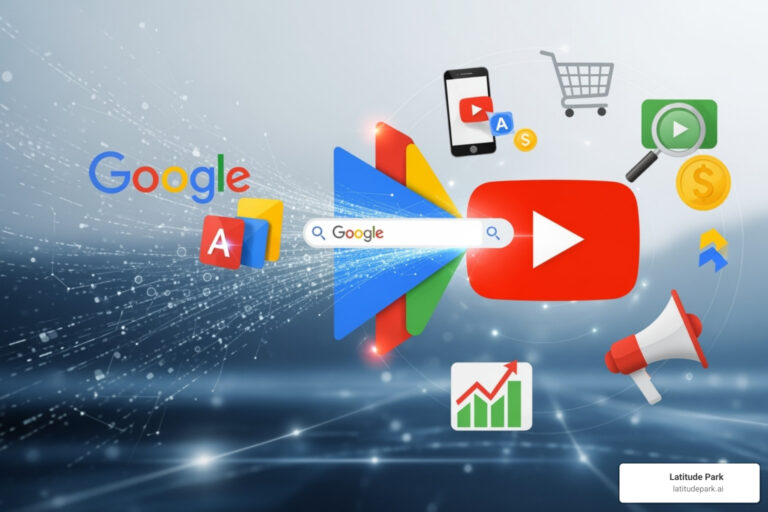Why Sales Teams Are Turning to Automation
Sales automation software is technology that handles repetitive sales tasks, freeing up sales teams to focus on building relationships and closing deals. These tools use artificial intelligence and workflow automation to streamline the entire sales process, from prospecting to deal closure, using tools like CRMs, outreach platforms, and AI assistants.
The numbers tell the story. Sales teams using automation see dramatic results, with some achieving a 182% increase in close rates and saving over 7 hours per week per salesperson on administrative tasks alone.
Here’s what’s really happening: sales reps are drowning in manual work. Between updating CRM records and sending follow-up emails, the actual selling gets pushed aside. One sales manager put it perfectly: “This sales tool doesn’t just reduce my admin work, it cuts my admin work more than half!”
Modern sales automation goes far beyond simple email sequences. Today’s tools use AI to score leads, predict which deals will close, and write personalized outreach. They automatically route prospects, sync data, and provide real-time coaching.
The shift is clear: teams that accept automation are closing deals faster while those stuck with manual processes fall behind. For franchise operations, this is critical for creating consistent processes that work at scale.
I’m Rusty Rich, President of Latitude Park, and I’ve spent over a decade helping businesses implement sales automation software to drive measurable growth. I’ve seen how the right automation stack can transform scattered sales efforts into predictable revenue engines.
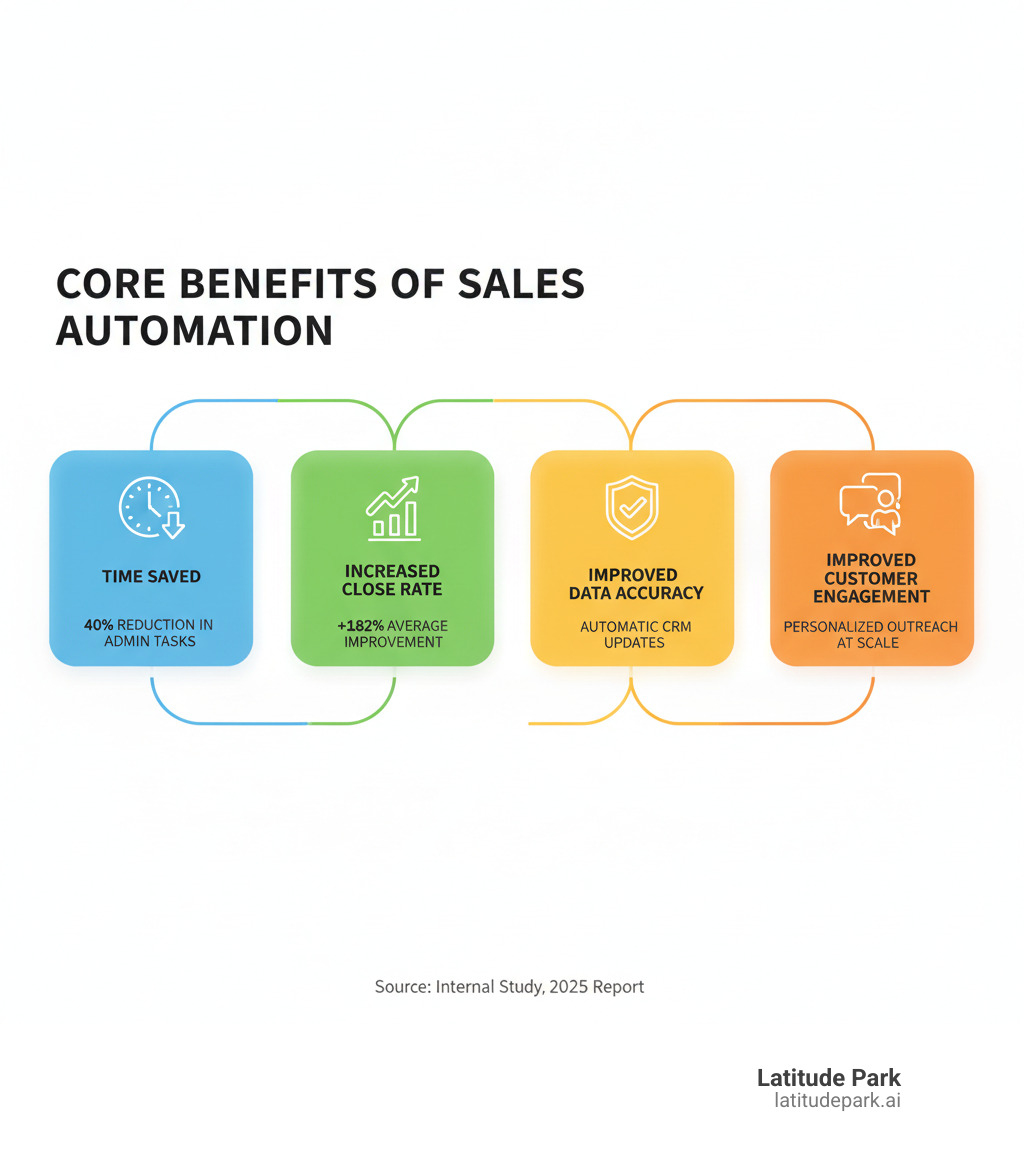
What is Sales Automation Software and Why Does it Matter?
Imagine your best sales rep spending hours on admin instead of selling. Sales automation software solves this by handling routine, time-consuming tasks. It’s like giving each rep a super-efficient assistant who never forgets a follow-up and always knows which prospect to prioritize.
Teams using this software report dramatic improvements, including 10x productivity increases and saving over 40% of their time on administrative tasks. It’s about doing more of the right work.
Lead management and scoring is the backbone. The software analyzes interactions and behavior to score each lead, flagging hot prospects for immediate attention while nurturing others. This prevents valuable opportunities from slipping through the cracks.
Automated lead routing then assigns prospects to the right salesperson based on territory or expertise in real-time, so reps can make contact while interest is high.
Email and communication automation sends personalized messages and schedules follow-ups based on when prospects are most likely to engage. Drip campaigns nurture leads over time with valuable content, keeping your brand top-of-mind without being pushy.
For more strategies on attracting quality prospects in the first place, check out our guide on Effective Strategies for Generating High-Quality Leads Online.
Sales analytics and reporting turn gut feelings into data-driven decisions. By tracking every interaction, you can identify what works, where coaching is needed, and where your pipeline has leaks. Performance dashboards offer a real-time view of your sales process, allowing managers to spot opportunities and reps to track their goals.
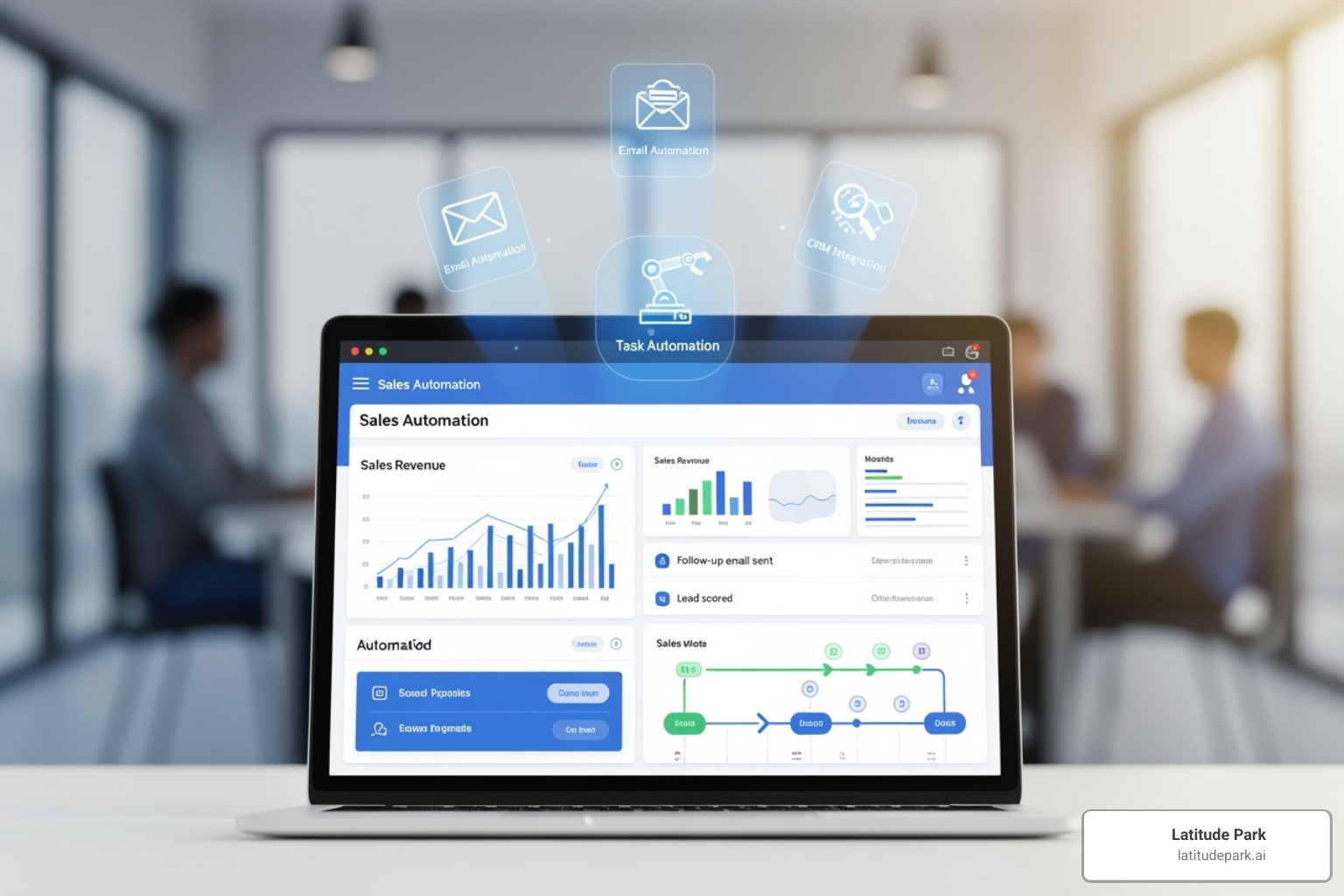
The real power comes from CRM and tool integration. Your sales automation software should connect seamlessly with your existing systems. APIs and webhooks enable this, allowing different platforms to share information automatically. This eliminates manual data entry and ensures everyone has up-to-date customer information.
For franchise operations, this unified approach is crucial. It ensures every location follows the same proven sales process, creating consistency across multiple locations without constant corporate oversight.
A Guide to the Different Types of Sales Automation Tools
The world of sales automation software is organized into a few key categories. Think of it like a toolbox—the best setup often involves combining several tools to create your perfect sales machine. Here are the four main types.
All-in-One CRM Platforms
These are the Swiss Army knives of sales automation, best for businesses that want unified data in a single dashboard. They combine sales, marketing, and customer service, creating a single source of truth for all customer interactions. Key features include visual sales pipelines, AI-driven insights, and comprehensive contact management. Their scalability allows you to start small and grow without migrating systems. Top examples include HubSpot, Salesforce, and Pipedrive.
Specialized Outreach & Prospecting Tools
When your main challenge is filling the top of your funnel, these tools are your best friend. They are designed for high-volume prospecting and focus on automating outreach through LinkedIn and email while maintaining a personal touch. Dripify, for example, uses hyper-personalization to make each message feel unique. These platforms excel at A/B testing, data enrichment, and managing massive outreach campaigns. The results can be transformative, with users reaching thousands of prospects monthly and seeing significant increases in close rates. This category represents a key type of sales automation software for competitive sales teams.
For businesses serious about nurturing those initial connections into real opportunities, understanding Lead Nurturing: Best Practices for Long-Term Success becomes crucial.
AI-Powered Sales Assistants
This is the fastest-growing category of sales automation software, and for good reason. These tools automate the administrative tasks that consume a sales rep’s day.
AI assistants can analyze sales conversations to craft personalized follow-up emails, transcribe meetings and sync insights to your CRM, or manage entire workflows from prospecting to scheduling. They learn from successful patterns to flag at-risk deals, suggest follow-up times, and even provide real-time coaching during calls. This category of sales automation software is rapidly growing, and its impact goes beyond just sales. To understand the broader implications, check out our insights on AI Digital Marketing: Opportunities and Challenges.
Integration & Workflow Automation Platforms
If you have great tools that don’t talk to each other, integration platforms are the solution. They are the “glue” that holds your sales operation together, connecting thousands of apps to create automated workflows. Zapier, for instance, connects over 8,000 apps and includes built-in AI for orchestration. These platforms eliminate manual data transfer, reduce errors, and ensure your tech stack works as one cohesive unit. For franchise operations, this is critical for maintaining consistent processes and data flow across all systems.
How to Choose the Right Sales Automation Software
Choosing the right sales automation software requires asking key questions to find a tool that fits your style and grows with you.
- Business Goals: What problem are you solving? Are you drowning in manual entry, or are leads slipping through the cracks? Your goals will determine if a free plan is enough or if you need sophisticated features for managing multiple franchise locations.
- Team Size & Structure: A small startup has different needs than an enterprise with multiple sales teams. Choose a tool that adapts to your structure.
- Sales Cycle Complexity: A complex sales journey with multiple touchpoints requires advanced workflow customization and lead nurturing. This is where a truly Integrated Digital Strategy becomes crucial.
- Integration Needs: Your new software must integrate with your existing tools, especially your CRM. Look for native integrations or connections via APIs or platforms like Zapier.
- Usability: A powerful platform is useless if it’s too complicated. Look for intuitive interfaces and strong onboarding resources to ensure team adoption.
- Scalability: Choose software that can grow with you, handling more leads, users, and evolving processes without forcing a switch later.
Understanding Pricing and Cost
Pricing is about more than the monthly fee; it’s about the value you receive. Here’s a breakdown:
- Per-User Models: Most software uses per-user pricing, from $10-$30 for basic plans to $75-$150+ for enterprise features. Examples include HubSpot ($9/seat/month), Salesforce ($25/user/month), and Pipedrive ($14/user/month).
- Tiered Plans: Expect Basic, Pro, and Enterprise levels. Free plans are great for testing but lack advanced features needed for growth.
- Billing Cycles: Annual billing often provides significant discounts (17-50%) compared to monthly payments.
- Usage-Based Costs: Watch for add-ons or credits for specific actions (e.g., leads), as these can add up with high-volume prospecting.
| Feature | Free Tier | Per-User/Month (Basic/Pro) | Enterprise Custom |
|---|---|---|---|
| Typical Cost | $0 | $10 – $75 | $75 – $150+ (or custom quotes) |
| Features | Limited core features, basic automation | Advanced automation, integrations, AI | Full suite, custom workflows, dedicated support |
| Users | 1-3 users, often limited | Scalable per user | Unlimited users, granular permissions |
| Best For | Startups, solo founders, basic needs | Growing SMBs, specialized teams | Large organizations, complex needs |
The key is matching your investment to your needs. A multi-location franchise might justify enterprise pricing for advanced territory management, while a single location could thrive on a mid-tier plan.
The Future is Automated: Key Trends and Outlook
The world of sales automation software is evolving rapidly, and the technological shifts happening today will transform how sales teams operate tomorrow.
Key trends are shaping this future:
- Generative AI: This is a game-changer. AI can now create personalized email sequences, write compelling proposals, and suggest conversation starters based on a prospect’s recent activity.
- Predictive Analytics: AI systems can now analyze historical data, market trends, and behavioral cues to forecast sales with incredible accuracy. This is critical for resource allocation in franchise businesses.
- Hyper-Personalization at Scale: Modern software creates unique experiences by tailoring the message, timing, and channel to individual preferences, something impossible to do manually.
- Revenue Operations (RevOps) Alignment: Sales, marketing, and service teams are unifying around shared data and revenue goals. This ensures every customer touchpoint is coordinated, which is essential for brand consistency across franchise locations.
- Mobile-First Functionality: The best platforms are designed for mobile first, allowing reps to update deals, send follow-ups, and manage their pipeline from anywhere.
- Cross-Platform Orchestration: Tools like Zapier connect thousands of apps, creating seamless workflows that span your entire tech stack. This eliminates data silos and manual intervention.
According to a McKinsey’s study on sales productivity, companies embracing these shifts are pulling ahead of competitors. The future of sales automation software is more intelligent, integrated, and customer-centric. To understand how these trends fit into the broader digital landscape, check out our insights on The Future of Digital Marketing: Emerging Technologies and Trends to Accept.
Frequently Asked Questions about Sales Automation
Here are answers to the most common questions business owners have about sales automation software.
How does sales automation improve team productivity?
Sales automation attacks time-wasters head-on. It eliminates manual tasks like data entry, automates follow-ups, and intelligently prioritizes leads so reps see their hottest prospects first. This frees up significant time for relationship-building and the crucial conversations that close deals. The results are powerful: some users report a 10x productivity increase. Automation also provides data-driven insights, helping your team make smarter decisions and refine strategies for better results.
Can sales automation software integrate with my existing CRM?
Yes, integration is a cornerstone of modern sales automation software. Most leading platforms offer native integrations with popular CRMs like Salesforce, HubSpot, and Zoho. For more unique setups, API connections, webhooks, and third-party connectors like Zapier can bridge almost any gap. Proper integration creates a unified customer view in your CRM, preventing duplicate outreach and ensuring every team member has the complete picture.
How does sales automation contribute to overall business growth?
Sales automation drives measurable growth by enabling you to scale outreach efforts without a proportional increase in headcount. It ensures consistent engagement, so no leads fall through the cracks. This leads to dramatic conversion improvements; some users see a 182% increase in close rates. With comprehensive data collection, you also gain accurate forecasting for better strategic planning. For franchises, this scalability is crucial for creating consistent, predictable growth across multiple locations.
Conclusion
The choice isn’t whether automation will reshape sales—it already has. The choice is whether you’ll leverage sales automation software to close deals faster and reach more prospects, or watch from the sidelines. The evidence is clear: teams using automation see dramatically higher close rates, save hours on admin tasks, and reach thousands more prospects.
Modern tools have evolved beyond simple email sequences. They use AI to predict outcomes, route leads, and write personalized outreach. By handling repetitive work, automation amplifies human strengths, freeing your reps to focus on understanding customer needs and building relationships.
For franchise operations, sales automation software is critical. It enables consistent, scalable processes across multiple locations without constant oversight, creating a foundation for predictable growth. At Latitude Park, we’ve seen how the right automation stack, combined with effective digital marketing, transforms sales efforts into revenue engines.
The future belongs to businesses that accept both automation’s efficiency and the value of human connection. Start with one tool, measure the results, and expand from there. Your sales team and your bottom line will thank you.
Ready to explore more ways to optimize your business operations? Check out our comprehensive guide to Small Business Automation Tools and find additional opportunities to streamline your processes.
